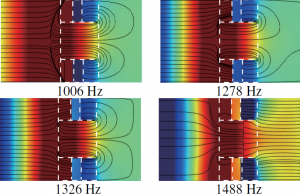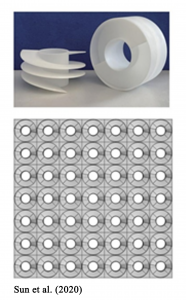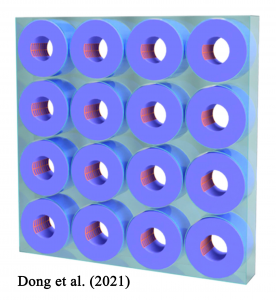
What Do You Mean Air Can Pass But Noise Cannot!
In our previous article, we talked about an acoustic metamaterial, which has noise-cancelling properties and was developed by Boston University researchers in the United States (See: No More Noise?).

If you remember, the striking property of this metamaterial is that despite it being so thin, 52mm, not only does it have the ability to block 94% of low-frequency sound (460 Hz) but it also allows air to pass freely. This material’s main drawback is the narrow frequency bandwidth at which sound is absorbed.
So, what do low-mid-high frequency and narrow-broadband actually mean? Scientifically speaking, sounds below 500 Hz may be defined as low-frequency, those in the range of 500-2000 Hz as medium-frequency, and sounds above 2000 Hz as high-frequency. Let’s take a look at the terms from the standpoint of the sounds produced by musical instruments. Sounds produced by a guitar correspond to approximately 80 Hz – 630 Hz, which makes it a low frequency and relatively wide-bandwidth instrument. On the other hand, a piano can be described as a broadband instrument that is effective at low, mid, and high frequencies, as it produces sounds in the range of about 28 Hz – 4100 Hz. A good example of a narrowband high-frequency sound is that of one’s fingernails scraping down a classroom blackboard.
 Returning to the main point, the metamaterial presented by the Boston University researchers only works in the narrow bandwidth. However, the options for this metamaterial appear to have increased. Broadband acoustic ventilation barrier designs come from the research group of Dongxing Mao and Yong Li, professors at the Institute of Acoustics, Tongji University in China. As a result of the studies carried out by the researchers in 2020 and 2021, respectively, the metamaterial can block 90% of the incoming sound in the medium frequency range (900-1418 Hz) with only 50 mm thickness, and 90% of the sound in the middle frequency range (650-2000 Hz) with only 53 mm thickness.
Returning to the main point, the metamaterial presented by the Boston University researchers only works in the narrow bandwidth. However, the options for this metamaterial appear to have increased. Broadband acoustic ventilation barrier designs come from the research group of Dongxing Mao and Yong Li, professors at the Institute of Acoustics, Tongji University in China. As a result of the studies carried out by the researchers in 2020 and 2021, respectively, the metamaterial can block 90% of the incoming sound in the medium frequency range (900-1418 Hz) with only 50 mm thickness, and 90% of the sound in the middle frequency range (650-2000 Hz) with only 53 mm thickness.
So, what distinguishes these acoustic ventilation barriers from conventional noise barriers?
As it is commonly known, noise barriers are one of the most effective methods for preventing noise. Conventional noise barriers block the flow of air between indoor and outdoor while preventing noise. Therefore, these kinds of materials fail to satisfy natural ventilation, but having said that, air permeability is expected in addition to the prevention of noise in some specific situations.
 For example, considering the increasing environmental noise pollution in today’s cities, it may be inevitable that outside noise enters green buildings, which use natural ventilation. That’s exactly the point, the air-permeable metamaterials, that have already been mentioned in this article, developmentally succeed the use of traditional materials due to more effective ventilation properties. Because of their ability of efficient air permeability and broadband sound insulation, acoustic ventilation barriers look like a promising area for solving noise problems in many fields, such as green buildings, HVAC (Heating, Ventilating, and Air Conditioning) systems, etc. However, in parallel with these developments, architects and engineers should watch closely the use of metamaterials, which work quite differently from traditional materials, as these may be part of innovative building designs.
For example, considering the increasing environmental noise pollution in today’s cities, it may be inevitable that outside noise enters green buildings, which use natural ventilation. That’s exactly the point, the air-permeable metamaterials, that have already been mentioned in this article, developmentally succeed the use of traditional materials due to more effective ventilation properties. Because of their ability of efficient air permeability and broadband sound insulation, acoustic ventilation barriers look like a promising area for solving noise problems in many fields, such as green buildings, HVAC (Heating, Ventilating, and Air Conditioning) systems, etc. However, in parallel with these developments, architects and engineers should watch closely the use of metamaterials, which work quite differently from traditional materials, as these may be part of innovative building designs.
REFERENCES
- 1. http://physics.tongji.edu.cn/Web/Show/1389
- 2. http://physics.tongji.edu.cn/Web/Show/1126
- 3. https://onlinelibrary.wiley.com/doi/pdf/10.1002/9781119164746.app2
- 4. Ruizhi Dong, Dongxing Mao, Xu Wang, and Yong Li, Phys. Rev. Applied 15, 024044 – Published 18 February 2021
- 5. Man Sun, Xinsheng Fang, Dongxing Mao, Xu Wang, and Yong Li,Phys. Rev. Applied 13, 044028 – Published 10 April 2020
- 6. Reza Ghaffarivardavagh, Jacob Nikolajczyk, Stephan Anderson, and Xin Zhang, Phys. Rev. B 99, 024302 – Published 4 January 2019
